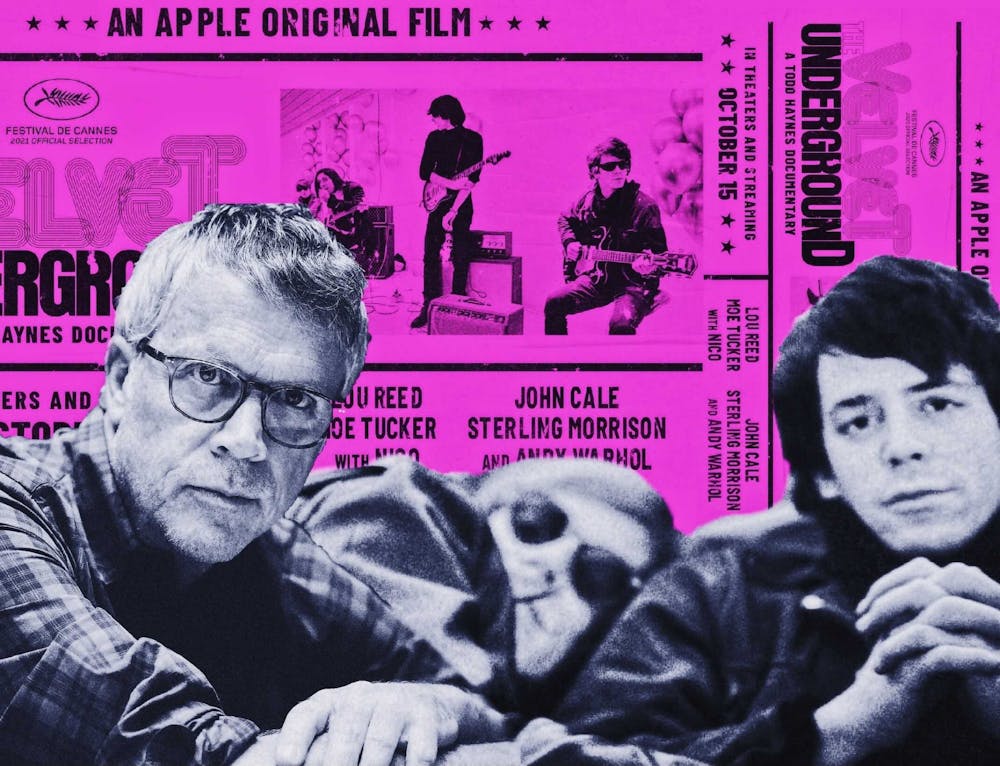Todd Haynes’ The Velvet Underground translates the band into energy, embodying the people, art, and sounds of New York City during the rise of experimental rock. The 2021 documentary mimics the hypnotic nature of Andy Warhol’s influence and The Velvet Underground at its height. Similar to Warhol’s work, Haynes’ documentary holds the potential to “extend time,” drawing out the narratives of each band member and their respective contributions to the group. Rather than creating a chronological—or purely historical—account of The Velvet Underground, Haynes recreates the same temporal dissonance that is emulated in their music. By doing so, Haynes expands the definition of the band, whose influence has extended beyond the music industry and into a cultural phenomenon.
Much like the band, Haynes invites the audience to escape themselves. This can be observed at the very opening of the documentary: The animated letters of "The Velvet Underground" flash across the screen while the beat of “Venus in Furs” drones in the background. The viewers’ imagination is intertwined with the sounds of the radio. This mesmerizing visual illustrates the same quality as the music—to immerse the listener within the band’s rhythmic entropy.
The medium of the documentary itself mirrors the multimedia lens of Warhol. Archival footage paired with interview clips constructs a kaleidoscopic narrative. Similarly to the band’s early live shows, the film overlaps sounds, vivid visuals, and grainy video snippets. While watching Haynes’ film, one can consider how the immersive nature of the documentary mimics that of a concert. Flashing jewel–toned lights are displayed while recordings of cheering crowds draw viewers in—and eventually consume the audience.
Haynes’ account of The Velvet Underground weaves together art and politics. Through second–hand accounts of the band members, Haynes builds a sparkling profile of The Velvet Underground, Warhol, and the power dynamics between them. Haynes’ priorities lie in creating a nuanced account of Lou Reed’s life and character. Notably, Haynes chooses to interview Reed's sister, who provides an alternate perspective on his stormy mental health struggles. Viewers see how Reed speaks his fame into existence, describing he wanted “ultimately to become a rockstar” in high school. On the other hand, Nico—described as a “blonde iceberg amongst figures dressed in all black”—is cast as a wanderer. She seeks to define herself beyond her immediate beauty. Despite tensions, Haynes demonstrates how the tug–of–war between the bandmates' motivations ignited their path to success. Here, the documentary welcomes the viewer into the crippling, yet irresistible process of making unforgettable art.
With vibrant interviews from musicians ranging from Jonathan Richman to David Bowie, viewers absorb the palpable impact of The Velvet Underground long after the band’s initial ascension to fame. By translating music into influence, the documentary depicts how the band established a cultural pulse that outlives its controversial reputation.
Without explicitly stating so, the documentary shows how The Velvet Underground changed the unconventional into the desired. When dissecting New York City’s cultural scene, the film incorporates attitudes towards sex, drugs, war, and the fleeting moments in between. At the heart of it all, people inch closer to the seduction of fame within the walls of Warhol’s New York City studio, known as The Factory. Undoubtedly, the viewer begins to understand how the band members chose to do what they wanted, approaching convention with disinterest. We are given a glimpse into the world of The Factory: an open space for people to exist, observe, and dance along the edges of notoriety.
Lastly, the documentary illustrates the transient nature of fame. The band’s swelling rise and inevitable falling–out serves as an escape from the mundane. Even through the screen, a discernible flicker of nostalgia glows behind the wrinkled eyelids of interviewees as they recall the New York of the past. At the end of the film, viewers seem to join Reed and Warhol at their coffee table, reminiscing on their shared history that bleeds into the future we now know is the past.
Within Haynes’ hands, the viewer exists at the same frequency as the music. While a reel of life updates on each character rolls at the end of the documentary, the audience’s applause is suspended. The Velvet Underground provides a biting depiction of how culture is molded and unraveled—how the experimental becomes timeless.

